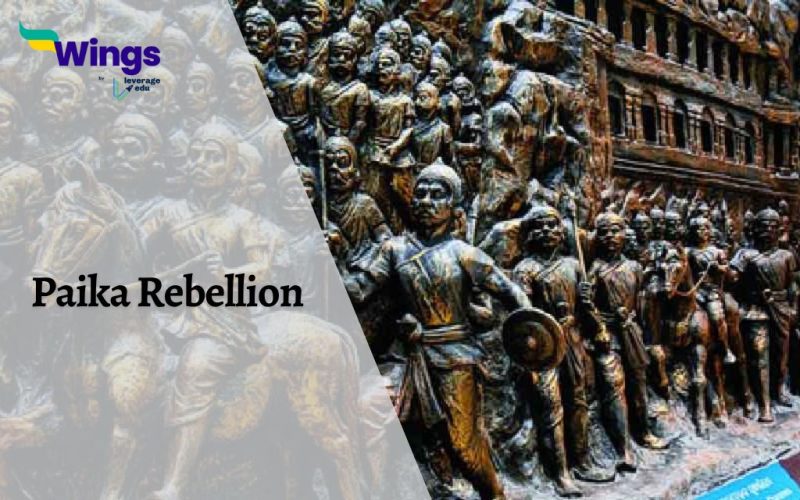The Paika Rebellion of 1817 refers to one of the most popular and earliest armed movements to gain independence in the history of India. Also known as the Paika Bidroha, this rebellion occurred in Odisha and was launched against the unjust and oppressive rules and policies framed by the East India Company during its rule in India. Moreover, the rebellion was led by Bakshi Jagabandhu. In this blog, we will explore the causes of this rebellion and the subsequent consequences. Let us begin.
Table of Contents
Who were the Paikas?
In the Odiya language, Paikas translates to warrior/fighter. They were the traditional militia or warriors found in Odisha and were responsible for looking maintaining law and order for Gajapati rulers. The roots of their peculiar fighting style can be traced back to ancient Kalinga. Moreover, Paikas were further divided into:
- Dhenkias- Dhenkias were the archers.
- Praharis- They were swordsmen
- Banuas- Banuas were expert matchlock fighters
Also Read: Indigo Rebellion: Causes, Outcome, and Significance
British Conquest of Odisha
- The British forces, driven by their relentless pursuit to expand control over the Indian subcontinent, seized control of Odisha.
- This conquest marked a turning point in the history of this kingdom.
- Upon the success of this conquest, the British government enforced numerous tyrannical land reforms, destroyed common trade routes, and interfered in the internal affairs of local rulers.
- The government established its monopoly over the production of salt and trade. Moreover, they also increased the price of salt significantly.
- Such tyrannical measures, paired with the dethronement of Raja of Khudra, Mukunda Deva II sparked a rebellious spirit among the Paikas.
Causes of the Rebellion
There were numerous social, economic, and political reasons behind the Paika Rebellion such as:
- In 1803, Britishers took over Odisha and introduced numerous reforms that were against the peace and harmony of the Paikas.
- The King of Khurda, Mukunda Deva II, was dethroned which made the crowd hostile towards the regime.
- The East India Company closed Odisha’s four main trading posts which subsequently isolated the local population of the region.
- The government forcefully occupied the lands of Paikas which angered the crowd and local leaders.
- The government also banned the production of salt from seawater.
- There was a surge in taxes imposed on the people.
- The Paikas were subjected to oppression at the hands of the East India Company.
- The government introduced a new type of currency by eliminating the cowrie currency which prevailed in Odisha before its conquest. Moreover, tax payments were requested in silver.
- The Paikas also lost their traditional status in the society.
Course of the Rebellion
- The Paika Rebellion happened under the leadership of Bakshi Jagabandhu.
- Apart from him, Raja Mukunda Deva, the last Khurda king, was another prominent leader of the rebellion.
- Bakshi Jagabandhu led the army and confronted the opponent forces on April 2, 1817.
- While the rebellion began somewhere in Banapur and Khurda, it quickly spread across other regions of Odisha such as Kujang, Pattamundai, and Kujang.
- The rulers of other regions such as Ghumsur, Kanika, and Nayagarh also extended their aid and resources to Jagabandhu in fighting the oppression.
- The Paikas attacked numerous prominent British symbols of power such as police stations, and administrative offices, and looted the British treasury.
- Upon gradual defeat by the British government, Paikas returned to the lush jungles of Odisha and carried out their warfare for several more years.
- After multiple defeats, Jagabandhu eventually surrendered to the British in 1825.
Also Read: The Moplah Rebellion: History, Significance, Result
Result of the Paika Rebellion
Here are the consequences of the Paika Rebellion:
- The East India Company appointed a commission to look into the Paika Rebellion.
- The rebels involved in the Paika Rebellion were imprisoned and given death sentences.
- The rebellion saw massive support from various sectors of the society including the zamindars and chiefs which united the region.
- Since the rebellion failed to achieve the desired revenue and taxation changes, the country witnessed numerous other smaller rebellions.
Legacy of the Rebellion
- The Paika Rebellion (1817) is remembered as a symbol of resistance against the oppressive and unjust British rule.
- It reflects the courage and unwavering spirit of the rebellious leaders involved in the movement.
- The rebellion served as a source of inspiration for other smaller rebellion movements that fought for self-determination and justice.
- Moreover, on 24 December 2018, India’s Prime Minister Narendra Modi released a commemorative stamp and coin in honor of the Paika Rebellion.
- Even today, the rebellion continues to spark honor in people’s hearts for the brave souls of the martyrs.
Also Read: The Vellore Mutiny of 1806
FAQs
The Paika Rebellion of 1817 was led by Bakshi Jagabandhu. He was the former commander of the forces under the Raja of Khurda.
The Paikas were angry with the East India Company as the government took over their land, imposed high taxes, introduced a new currency, and went ahead with other atrocities.
As stated earlier, Paikas translate into warrior or fighter. Paikas were military soldiers from varying social classes who fought battles for the kings of Odisha. Moreover, they also rendered their military services in exchange for titles and rent-free land.
This blog was all about the Paika Rebellion. If you want to read more such informative blogs, then stay tuned to our dedicated General Knowledge page.
 One app for all your study abroad needs
One app for all your study abroad needs













